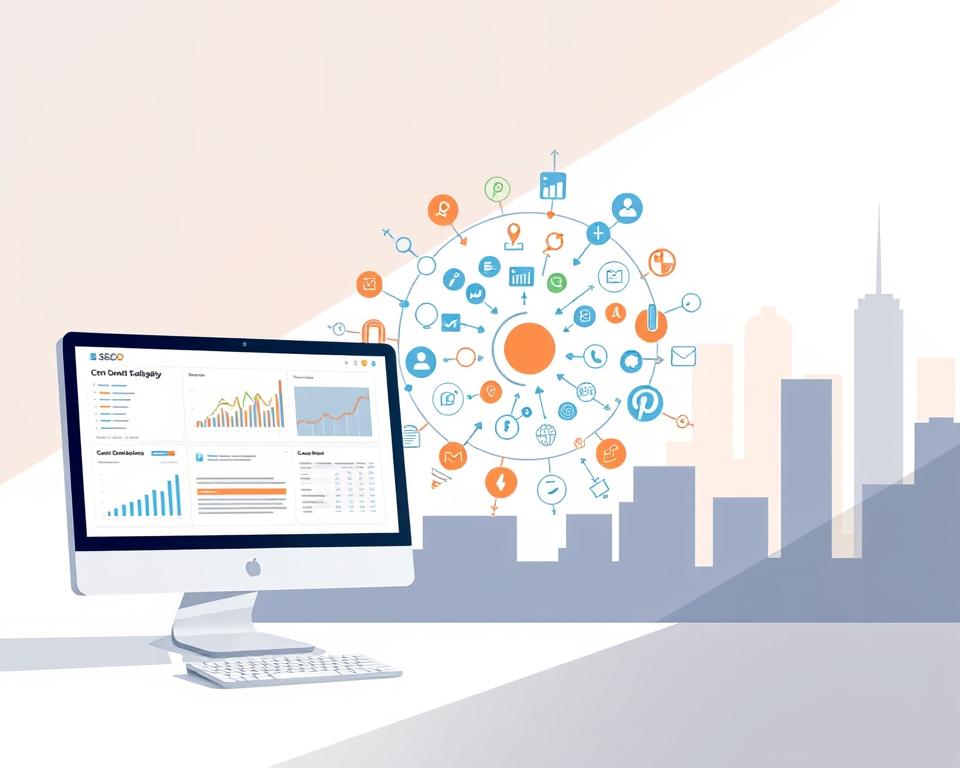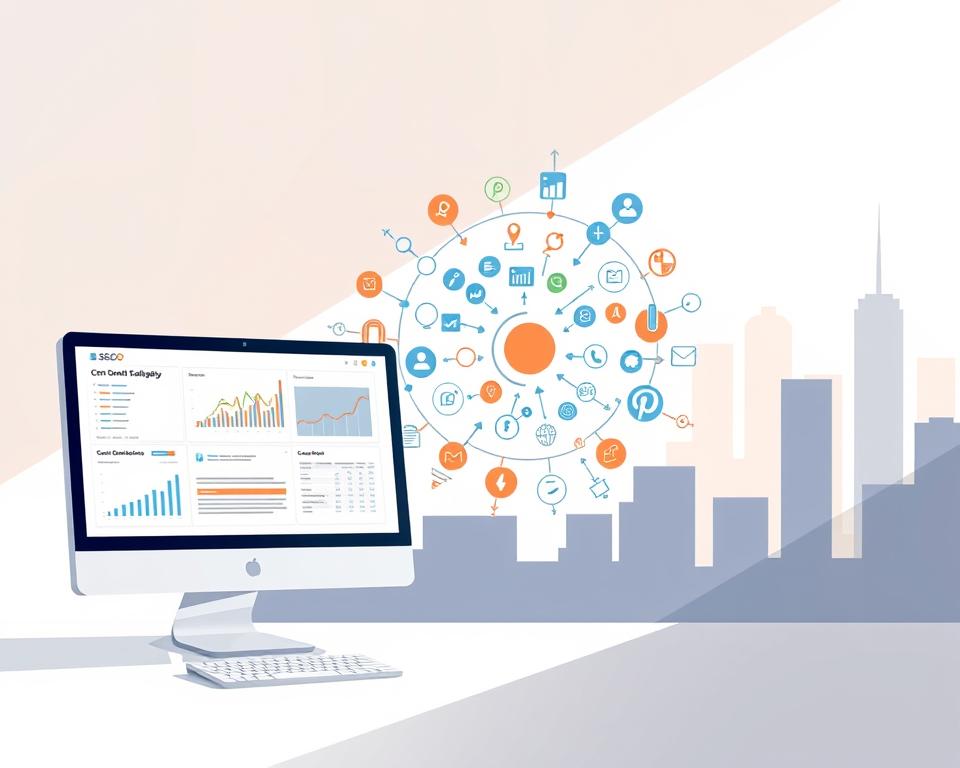The Transformation of Development of Online Marketing: A Voyage
Have you heard that over 170 million individuals regularly engage with social platforms, effectively altering the advertising environment? As customers more and more move to digital platforms, online marketing has surfaced as a pivotal tactic. It permits companies to engage clients on channels where they spend a significant part of their attention. This transition marks the development of online marketing transitioning from classic techniques to a more dynamic and involved methodology.
With an projected online advertising market worth of about two hundred billion dollars, it’s apparent that Henderson Digital Marketing Company must evolve to the ongoing internet marketing trends. This is vital to maintain competitiveness in this rapidly changing market.
The rise of online channels has allowed businesses to access customers that conventional advertising techniques struggle to target. It’s no longer required when a basic ad in a magazine would meet the need. Today, targeted marketing strategies have taken center stage, using tools like SEO strategies, social networks, and collaborations with influencers.
As we investigate the development of digital marketing, we will explore major milestones and trends. These have shaped the existing marketing framework. We will illustrate the unprecedented opportunities and difficulties experienced by businesses in this digital age.
Main Points
- More than 170M users consistently interact on social media platforms, creating wide-ranging advertising opportunities.
- Digital marketing is to be more affordable than conventional techniques, allowing wider reach with reduced costs.
- The global digital advertising market is projected to reach $517 billion by the close of 2023.
- Precision strategies like SEO enhance web visibility and participation for brands.
- Digital influencers have created a $1 billion market, changing brand advertising.
- Organizations employing mobile marketing strategies can access the increasing consumer dependence on smartphones.
- Investing in online marketing tools, like AdWords, enables for exact targeting based on demographics.
Digital Marketing Basics
Online marketing encompasses a wide range of advertising activities across various online platforms. This includes social media, email marketing, search engines, and online sites. It’s a crucial component of modern marketing, due to the rising internet engagement between customers and brands. Organizations that comprehend the basics of online marketing can develop plans that successfully interact with their target audiences.
The evolution of internet marketing is driven by evolving consumer behaviors. The emergence of mobile devices has transformed marketing and sales. Nowadays, companies use multi-channel strategies to address the needs of consumers who use a range of devices and platforms. Given the attention span of Generation Y and Generation Z, content pieces must be compelling and powerful from the beginning. Findings show that integrating video content can enhance communication effectiveness by up to three hundred percent.
The rising role of online marketing highlights the necessity to remain updated of emerging trends and technologies. Tools like AI-driven chatbots facilitate profound customer interaction, while social media influencers aid establish trust with audiences. Classic advertising methods are no longer sufficient, highlighting the importance of integrated digital strategies that meet modern buyer needs.
| Element | Information |
|---|---|
| Buyer Behavior | Move towards digital engagement, shorter attention spans (twelve seconds for young adults, eight seconds for Generation Z) |
| Technology Usage | Growth of mobile devices, expansion of interactive technologies |
| Promotional Strategies | Concentration on multi-channel and influencer marketing |
| Engagement Tools | Utilizing artificial intelligence chatbots and video content in campaigns |
| Industry Evolution | Increase in digital advertising post-2000, emergence of PPC advertising with platforms like Google Ads |
Defining Digital Marketing
Digital marketing includes a array of strategies to connect with customers through digital channels. It covers SEO strategies, content strategies, and social media interaction. The primary goal is to effectively connect with and interact with target audiences using extensive data and cutting-edge technologies.
The growth of internet advertising has been significant in the past few years. As companies immerse themselves into the digital realm, the need for effective online marketing tools grows. For example, 53% of all internet traffic originates from natural search results, highlighting the role of SEO in increasing visibility and website traffic.
Content marketing innovations are key to a brand’s communication with potential customers. The content marketing field is projected to reach $2 trillion by 2032. It’s essential for organizations to evolve their strategies to effectively utilize these programs. Compelling content fosters connections, enhancing customer loyalty and brand awareness.
Moreover, the crucial nature of robust Customer Relationship Management (CRM) tools has increased. Companies that employ customer data can create precision marketing campaigns. This causes improved engagement and conversion rates.
In closing, online marketing is a constantly changing driver for businesses looking to boost their online presence. By embracing the most recent in online advertising and advanced content marketing, companies can enhance online visibility and drive higher customer engagement.
The Evolution of Digital Marketing
The advertising landscape has seen a significant shift over the years. The development of online marketing demonstrates how the online world has transformed business communication with clients. As conventional methods became old-fashioned, digital platforms emerged, providing fresh approaches to connect with customers and measure results.
From Traditional to Digital: A Major Shift
The shift from conventional to digital marketing has dramatically transformed the advertising industry. Classic techniques like print advertising, radio media, and television advertising presented restricted interaction. Digital advertising, however though, permits instant engagement and performance metrics. The initial clickable banner advertisement in 1994 marked the start of digital marketing as we recognize it today.
This change allowed businesses to test and refine their approaches, leveraging the internet to engage consumers.
The Birth of the Internet and Digital Marketing
The internet’s emergence introduced a fresh marketing age. At first, companies created online sites, setting the stage for internet marketing. The late 1990s saw the rise of search tools like Yahoo! and Alta Vista Search, emphasizing the importance of SEO in online marketing.
This shift opened new avenues for reaching audiences actively searching for goods and services, drastically altering consumer-company connections.
| Timeline | Milestone | Impact on Digital Marketing |
|---|---|---|
| 1994 | First interactive banner ad on HotWired.com | Starting point for online advertising |
| 1998 | Popularity of search engines rises | Birth of SEO as a marketing tool |
| 2002 | Google releases AdWords | Changed online advertising with PPC |
| 2004 | Facebook introduced | Provided vast engagement opportunities |
| 2007 | Debut of the iPhone | Led to the rise of mobile marketing |
| 2012 | Content marketing gains recognition | Meaningful and significant content becomes vital |
The 1990s: Digital Marketing Emerges
The Nineties were a groundbreaking era for advertising, setting the stage for current digital landscape. The initial website was created in 1991 by Tim Berners-Lee, indicating a crucial transformation in brand-audience connections. Search tools became essential for exploring the expanding online space.
Major Milestones of the 1990s
Several significant events shaped the 1990s, laying the groundwork for the future of digital marketing:
- 1991: The creation of the initial website sparked a surge in digital content interest.
- 1994: The launch of the first clickable banner ad paved the way to digital advertising.
- Early search engines like Archie appeared, introducing users a method to locate digital information.
- Platforms like Yahoo Search grew, heavily impacting the online user experience.
Search Engines’ Influence
The 1990s saw a profound effect from search engines. As businesses realized the value of online visibility, SEO became essential. Brands adjusted to search engine changes to boost their visibility to audiences. This indicated a transition from basic brand recognition to a focus on visibility and engagement, underscoring search engines’ pivotal role in digital marketing.
2000s: The SEO and Social Media Transformation
The 2000s experienced a substantial transformation in online marketing, driven by the growth of SEO and social platforms. Organizations focused on boosting their online presence, causing a boom in SEO strategies. These modifications reshaped how businesses communicate with customers and how marketing approaches evolved.
Rise of Search Engine Optimization (SEO)
Businesses comprehended the value of search tools as principal information providers. SEO evolved into crucial, with online platforms emphasizing content and keyword enhancement. The early 21st century introduced PPC advertising, increasing digital advertising alternatives. This laid the groundwork for advanced analytics and big data in marketing.
The Development of Social Media Platforms
Platforms like Facebook, Twitter, and LinkedIn turned into mainstream, altering social media. They allowed companies to engage with users and deliver focused advertisements. The late 2000s decade also saw the growth of mobile marketing, with the expansion of smartphones shaping strategies.
With over 170M each day users, social media’s effect on brand visibility was massive. Marketers commenced working with influencers, increasing brand awareness and sales. Social media evolved into a crucial part of modern digital marketing.
The Impact of Online Advertising Advancements
The digital marketing landscape has gone through a significant metamorphosis with the advent of online advertising advancements. Programmatic advertising has transformed how brands engage with their audience. In the U.S., more than 90% of digital display ads depend on programmatic methods for success. This advancement allows personalized ad delivery, ensuring the appropriate message gets to the intended consumer.
Digital marketing trends show a growth in native advertising efficacy. This strategy, combining ads into user experiences, often outperforms traditional methods in engagement. Additionally, leveraging mobile app advertising has turned into crucial, tapping into the viral capacity of these platforms to enhance visibility.
Augmented reality in content marketing is gaining momentum. It combines digital content with real-world environments, developing engaging experiences. Progressive web applications (PWAs) also concentrate on user experience, highlighting speed and clarity, fulfilling current consumer demands.
With approximately 315 million Americans engaged on social media in 2023, mobile optimization is more critical than ever. A substantial portion of advertising budgets is dedicated to mobile ads, acknowledging the lengthy time users spend on their devices. This shift not only enhances user experience but also increases conversion rates, fueling revenue growth.
The adoption of AI tools has significantly advanced online advertising. Tools like Albert allow predictive analysis for pay-per-click campaigns, aiding marketers improve strategies with real-time data. AI-driven automation improves marketing efficiency, allowing brands to stay competitive in a fast-changing market.
- Programmatic advertising increases targeting efficiency.
- Native advertising often surpasses traditional methods.
- Augmented reality crafts engaging marketing experiences.
- Mobile promotion concentrates on optimizing user experience.
- AI tools offer predictive insights for campaigns.
Adapting to digital marketing trends guarantees brands maintain competitiveness in the constantly evolving digital landscape.
2010s : Period of Personalization
The 2010s decade experienced a major shift in digital marketing, with a focus on personalization. Advances in data analytics allowed companies to customize their marketing to fit individual preferences and behaviors. This period emphasized the value of creating content that resonates with users, boosting engagement and loyalty.
Focused Marketing Strategies
Marketers in this decade turned towards customer data to develop targeted campaigns. By understanding consumer behavior, brands could send personalized messages on various platforms. Personalization efforts included:
- Flexible website content that adapts based on user interactions.
- Tailored email campaigns customized for individual preferences.
- Behavioral retargeting ads that pursue users across the web.
This concentration on targeted marketing enabled brands connect with their audience more deeply. It led to higher customer satisfaction and conversion rates.
The Function of Data Analysis in Marketing
Data Analysis evolved into crucial in the 2010s, aiding businesses turn vast data into useful insights. Companies used analytics to track campaign success, user engagement, and predict future behavior. Key aspects included:
- Utilizing predictive analytics to predict customer needs and trends.
- Employing A/B testing to improve advertising approaches based on real-time data.
- Integrating social media analytics to measure audience sentiment and preferences.
The increase of data analytics altered how marketers strategized, allowing them to create more relevant and engaging experiences. This evolution established the foundation for future trends, solidifying a customer-centric approach in digital marketing.
The Influence of Mobile Technology
The rise of mobile technology has dramatically altered the digital marketing landscape. In recent years, the shift towards mobile devices, especially smartphones, has altered consumer engagement with brands and information access. By 2021, about 85% of Americans held smartphones, a considerable jump from 35% in 2011. This growth in mobile device usage has led to changes in digital marketing strategies across various sectors.
As mobile technology advances, brands have grown their investment in mobile ads. An astonishing $7 out of every $10 spent on advertising now goes to mobile ads. In 2020, mobile ads made up around 70% of all internet ad revenues. This demonstrates a clear consumer preference for mobile-friendly experiences. Businesses have accordingly focused on responsive web design and mobile optimization for seamless interactions.
- Fifteen percent of Americans rely exclusively on their smartphones for internet access.
- Mobile optimization has turned into essential for consistent user experiences across devices.
- Social media platforms like Facebook and Instagram have employed mobile technology to boost brand visibility.
- Data-driven marketing strategies allow improved understanding of customer preferences.
The development of digital marketing has also seen a shift towards personalized and targeted marketing. This has led to better engagement and conversion rates. Analytics tools have turned into crucial for marketers aiming to tailor their campaigns effectively. Innovations like virtual reality (VR) and augmented reality (AR) have opened new avenues for customer engagement, emphasizing the dynamic relationship between mobile technology and digital marketing strategies.
Looking ahead, future trends will continue to integrate technology and marketing innovation. Google’s decision to eliminate third-party cookies in 2023 will necessitate businesses to adapt their smartphone marketing tactics. Ethical concerns around data protection will mold consumer trust and influence marketing practices. As consumer behaviors evolve with mobile technology, brands must stay flexible to embrace emerging opportunities within the changing digital marketing landscape.
Present Digital Marketing Trends
The development of digital marketing is in progress, with several trends molding how businesses interact with consumers. Artificial intelligence and machine learning are transforming marketing strategies. These technologies facilitate more personalized experiences, causing higher engagement and conversion rates through data-driven approaches.
Social media platforms have seen significant growth since their introduction in the mid-2000s. They have become essential for brand engagement, allowing businesses to connect with audiences on a personal level. Moreover, social media SEO is an emerging field, offering opportunities for content creators to improve their search engine rankings.
Video marketing is a leading technique, reflecting a preference for visual content. With growth projections, marketers must focus on creating video content to meet consumer demands.
Voice search optimization is another key trend, driven by the increasing use of voice-activated devices. Brands must adjust their content strategies to address voice queries, ensuring relevance as technology advances.
As data privacy regulations strengthen, the digital marketing landscape will change. Marketers must comply with these regulations while maintaining personalized experiences. Finding a balance between handling customer data and tailored marketing is crucial for engagement in this constantly shifting digital world.
Google’s dominance in online information retrieval, with around 90% market share, highlights the need for perfecting SEO strategies in 2024. The shift towards AI snippets and visual content is transforming SEO focus, demanding brands to improve their strategies in response.
| New Technology | Effect on Marketing | Engagement Potential for Consumers |
|---|---|---|
| Generative AI | Enhances content production and personalization | High |
| Virtual Reality (VR) | Develops immersive experiences for users | Very High |
| Augmented Reality (AR) | Improves product interaction through digital overlays | High |
| Internet of Things (IoT) | Associates devices to gather user data for targeted marketing | Moderate |
As brands investigate this new landscape, their ability to adapt will shape the future of digital marketing. Integrating these technologies is not just about keeping pace; it’s about redefining customer-brand interactions. This will create a more personalized and engaging marketing environment.
Conclusion
The development of digital marketing has been a journey of constant innovation and adaptability. From the early internet days in the 1990s to today’s advanced strategies, businesses have always adapted. The increase of SEO, social media, and artificial intelligence shows the need for marketers to keep up with new strategies to stay ahead.
In the 2010s, methods like Media Mix Modeling and Multi-Touch Attribution created new standards for measuring marketing success. The COVID-19 pandemic also showed how crucial digital channels are for businesses to reach their audiences. Keeping up with these changes is essential for brands aiming to succeed in our digital-first world.
Therefore, businesses must remain vigilant and proactive in their digital marketing efforts. By adopting new technologies and trends, they can better connect with their audience. Embracing continuous change in digital marketing strategies will improve brand visibility and create stronger connections with consumers in today’s interconnected market.



